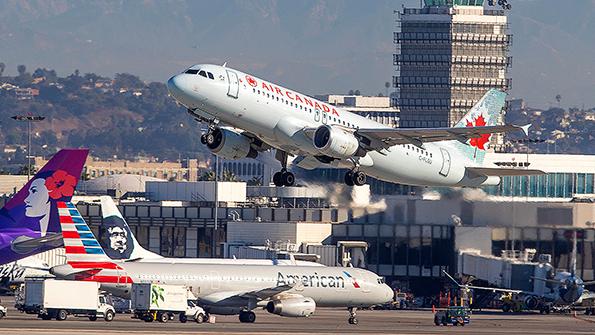
One continent, two stories. That’s the best way to sum up the Americas’ air transport industry. North America remains “the standout region in terms of financial performance,” IATA notes. Meanwhile, many markets in South America continue to face economic and social turmoil that negatively impacts airline performance.
Airlines in the US and Canada as a collective were the first in the world to return to post-pandemic profitability in 2022 and they built on that performance through 2023. They are expected to post a net profit of $14.3 billion this year, with a margin of 4.2%, and another profit of $14.4 billion in 2024, with a 4% margin. Demand in RPKs is expected to be 16% higher this year than in 2022, which was 46% higher than the previous year, slowing to a 6.3% year-on-year rise in 2024. That will see demand outstripping capacity in ASKs slightly, which is expected to increase by 6%, meaning high load factors will continue.
“Consumer spending has remained solid, despite cost-of-living pressures, and the demand for air travel remains robust,” IATA says.
In contrast, airlines across Mexico, South America and the Caribbean are expected to post another loss in 2023—of $0.6 billion versus a $3.9 billion loss in 2022—and to still be in the red in 2024 to the tune of -$0.4 billion. Demand in RPKs in 2023 will be 16% higher than in 2022, then 7% higher year-on-year in 2024, when capacity in ASKs is expected to climb 8%.
Performance across the region is an uneven patchwork. Some markets, including Mexico, are strong, but others are weakened by economic instability and beset by high airport and airfare fees and taxes, and poor infrastructure. Adding to the challenges, capacity growth is expected to outpace demand in 2024.
Most US carriers, as the IATA numbers indicate, ended the year in decent shape and with reason to hope for a good 2024. For the international majors in the US and Canada, the strong return of the transatlantic market has been a particularly welcome revenue generator. But demand for wider international travel from and to North America is returning at a clip, while a post-pandemic uptick in demand for premium cabins has continued.
For the US majors, this likely means they will continue to focus next year on those routes that are in demand and profitable.
“We will have very little tolerance for what you would consider ‘investment’ or ‘development’ flying. We’re going to fly where we make money,” American Airlines CEO Robert Isom said during the company’s Q3 earnings call. By bringing in the Airbus A321XLR and reconfiguring its Boeing 777-300s, American will also grow its premium seating by 43% by 2026.
Delta Air Lines is similarly focused sharply on high income travelers—categorized as those earning $100,000 per year or more—who accounted for 75% of spending on air travel, with management seeing no slowing in the demand for premium, Morgan Stanley reported from its 3Q earnings call with the company.
Air Canada, meanwhile, is looking to build capacity in the Pacific market next year, adding routes and frequencies from Vancouver to Hong Kong, South Korea and Japan.
“There’s still a lot more recovery left on the Pacific and … it continues to be a very good opportunity for us to step into,” Air Canada EVP Mark Galardo noted.
TURBULENCE AHEAD
Even though North American carriers will again be the most profitable by region, it’s not going to be an easy ride. All are dealing with higher labor costs as new contracts, especially with pilot unions, have either been completed with significant hikes or will be negotiated in 2024. And many are dealing with ongoing supply chain issues and aircraft/engine delivery delays that impact their ability to maximize strong demand opportunities. Additionally, the US regional airline sector continues to weaken as mainline carriers prioritize limited resources on large city and international destinations and higher pilot wages price them out of the regional airlines’ reach. All this adds up to an anticipated year-over-year CASM pressure—hence IATA’s forecast for margins to stay essentially flat in 2024.
What will most be carefully watched in 2024, however, is the outcome of the proposed US airline mergers between JetBlue and Spirit Airlines and—the year-end’s big surprise—between Alaska Airlines and Hawaiian Airlines. The first question will be whether these mid-sized airline acquisitions get regulatory approval under a generally anti-merger US government. And if they do, what will be the terms (and concessions) and how will JetBlue-Spirit and Alaska-Hawaiian mergers impact the US market?
LATIN AMERICA BATTLES
In South America the challenges are different and, sadly, many could be addressed with different, more pro-aviation government policies.
Several carriers underwent restructuring through the pandemic years but are now back in growth mode. For Mexican airlines, in particular, demand for air travel is booming and FAA’s returning of Mexico’s aviation oversight status to Category 1 means those carriers can now resume adding capacity, frequencies and larger aircraft to their US routes.
But Colombia’s two ultra-LCCs, Viva and Ultra Air, ceased operations in 2023. Avianca, Colombia’s largest airline, wanted to purchase Viva, but the approval process by Colombia’s regulators dragged on while Viva’s financial state continued to deteriorate and eventually the airline went into liquidation. After Viva exited, LATAM—one of the carriers that underwent restructuring—moved to build its presence in Colombia and was awarded additional slots at Bogota El Dorado International Airport for the winter season. LATAM Airlines Group CEO Roberto Alvo said this was “very significant” and that LATAM Airlines Colombia will operate a network “that I think will help Colombians see LATAM as a real alternative to traveling, not only within Colombia, but also internationally.”
Avianca and Brazilian carrier Azul are also back in growth mode, with management expressing optimism for 2024 trends.
But the picture for most Latin American operators—even those performing relatively well—could be much brighter and the region’s sector could even be profitable if governments invested more in much-needed infrastructure rather than whack airlines with heavy fees, taxes and market restrictions. Until then, the Americas aviation industry will continue to be one continent, two stories.





